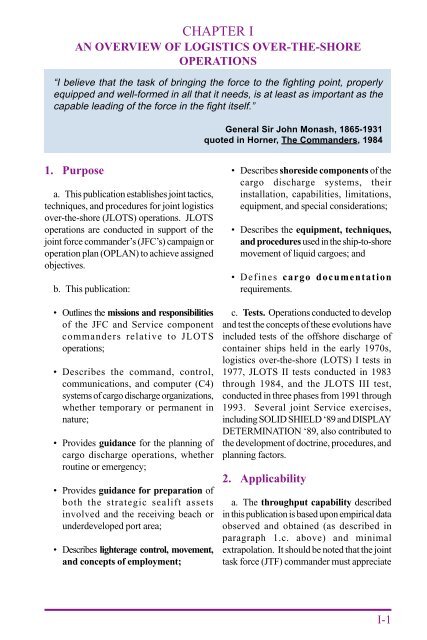JTTP for Joint Logistics Over-the-Shore - BITS
JTTP for Joint Logistics Over-the-Shore - BITS
JTTP for Joint Logistics Over-the-Shore - BITS
You also want an ePaper? Increase the reach of your titles
YUMPU automatically turns print PDFs into web optimized ePapers that Google loves.
CHAPTER I<br />
AN OVERVIEW OF LOGISTICS OVER-THE-SHORE<br />
OPERATIONS<br />
“I believe that <strong>the</strong> task of bringing <strong>the</strong> <strong>for</strong>ce to <strong>the</strong> fighting point, properly<br />
equipped and well-<strong>for</strong>med in all that it needs, is at least as important as <strong>the</strong><br />
capable leading of <strong>the</strong> <strong>for</strong>ce in <strong>the</strong> fight itself.”<br />
1. Purpose<br />
a. This publication establishes joint tactics,<br />
techniques, and procedures <strong>for</strong> joint logistics<br />
over-<strong>the</strong>-shore (JLOTS) operations. JLOTS<br />
operations are conducted in support of <strong>the</strong><br />
joint <strong>for</strong>ce commander’s (JFC’s) campaign or<br />
operation plan (OPLAN) to achieve assigned<br />
objectives.<br />
b. This publication:<br />
• Outlines <strong>the</strong> missions and responsibilities<br />
of <strong>the</strong> JFC and Service component<br />
commanders relative to JLOTS<br />
operations;<br />
• Describes <strong>the</strong> command, control,<br />
communications, and computer (C4)<br />
systems of cargo discharge organizations,<br />
whe<strong>the</strong>r temporary or permanent in<br />
nature;<br />
• Provides guidance <strong>for</strong> <strong>the</strong> planning of<br />
cargo discharge operations, whe<strong>the</strong>r<br />
routine or emergency;<br />
• Provides guidance <strong>for</strong> preparation of<br />
both <strong>the</strong> strategic sealift assets<br />
involved and <strong>the</strong> receiving beach or<br />
underdeveloped port area;<br />
• Describes lighterage control, movement,<br />
and concepts of employment;<br />
General Sir John Monash, 1865-1931<br />
quoted in Horner, The Commanders, 1984<br />
• Describes shoreside components of <strong>the</strong><br />
cargo discharge systems, <strong>the</strong>ir<br />
installation, capabilities, limitations,<br />
equipment, and special considerations;<br />
• Describes <strong>the</strong> equipment, techniques,<br />
and procedures used in <strong>the</strong> ship-to-shore<br />
movement of liquid cargoes; and<br />
• Defines cargo documentation<br />
requirements.<br />
c. Tests. Operations conducted to develop<br />
and test <strong>the</strong> concepts of <strong>the</strong>se evolutions have<br />
included tests of <strong>the</strong> offshore discharge of<br />
container ships held in <strong>the</strong> early 1970s,<br />
logistics over-<strong>the</strong>-shore (LOTS) I tests in<br />
1977, JLOTS II tests conducted in 1983<br />
through 1984, and <strong>the</strong> JLOTS III test,<br />
conducted in three phases from 1991 through<br />
1993. Several joint Service exercises,<br />
including SOLID SHIELD ‘89 and DISPLAY<br />
DETERMINATION ‘89, also contributed to<br />
<strong>the</strong> development of doctrine, procedures, and<br />
planning factors.<br />
2. Applicability<br />
a. The throughput capability described<br />
in this publication is based upon empirical data<br />
observed and obtained (as described in<br />
paragraph 1.c. above) and minimal<br />
extrapolation. It should be noted that <strong>the</strong> joint<br />
task <strong>for</strong>ce (JTF) commander must appreciate<br />
I-1
















